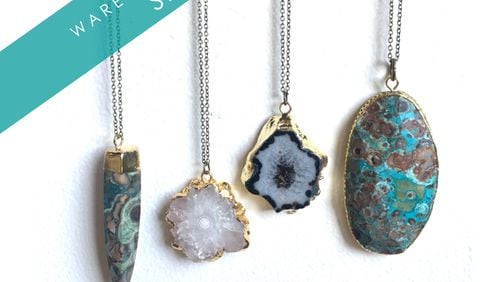If it's January, it is time for the Beehive Bi-Annual Warehouse Sale! The event, which has become an Atlanta tradition, starts at 9 a.m. on Saturday, Jan. 28 and runs through Sunday, Feb. 5.
The sale will feature a range of items from more than 50 local makers priced at 40 - 90 percent off the regular price. Most of the designers in the store will also offer their wares at prices 20-30 percent off all week long.
Items include handmade jewelry and accessories, stationery, wall art, housewares, clothing and toys for babies and children, bath and body goods and locally made artisan foods. The DIY and home crafting crowd will also find hundreds of supplies, fabric and jewelry on sale from $1 to $5.
Many of Beehive's popular designers are participating in the sale, as are a few first time participants including Cattywampus Crafts, Red Rocket Farm, Motto by Carruthers, Isea Designs, Little Woodlander, Made4U Art Creations , Ian Nicholas Designs and Daedal.
Get there early on Saturday to enjoy complimentary bites from Revolution Donuts and iced tea from Just Add Honey while supplies last.
Visit www.thebeehiveatl.com and www.thebeehiveatl.com/pages/warehousesale for additional information including a full list of participating designers. The Beehive Atlanta is located at 1250 Caroline Street, Suite C120, Atlanta.
Read on for a Q & A with Beehive owner, Malene Davis:
Q: How has the warehouse sale evolved over the years?
A: The Warehouse Sale originated in the Beehive’s first retail location on Peachtree Street over 10 years ago. It included 20 designers and like many other liquidation sales, was used solely as a way for designers to rid themselves of past season items. Discounts ranged from 20 to 25 percent off.
Over the years, I identified the sale as a way to create earning opportunities for designers during two of the slowest retail sales months of the year – January and August – turning what is typically a “down” earning month into a “high” earning month for those who participate.
Once we opened in our current location in the Edgewood Retail District, we modified the back portion of our store to include more participating designers, and as an incentive for customers to shop, made the minimum mandatory discount to participate 40 percent off. We understand that while customers enjoy a 20 percent off sale and will be happy they receive it when they’re shopping, that discount is not high enough to make them travel to shop. Many, however, will travel for sales 40 to 90 percent off, so that became our standard for the sale and has been for the past six years.
Today, we have 50 to 60 designers who participate in a storewide sale that includes every category of design in the store. The sale has become competitive for our designers, and while most of them use the opportunity to clear out old stock, irregulars and supplies from their studios, many also make products particularly for the Sale.
We are fortunate that customers come from all over the South to attend the sale bi-annually, and that we’ve provided our designers with a platform that affords them the opportunity to earn thousands of dollars in just one week’s time, when they typically would not. It helps to bolster their planning and spending into the next quarter for their businesses.
Q: How has the makers movement in Atlanta changed?
A: I believe it has become more competitive. Fifteen years ago, festivals were all rendered “fine arts festivals” and were reserved exclusively for those who create large-form paintings, sculpture, hand-forged jewelry and ceramics.
Today, festivals that previously would not accept, for example, a designer that does felted hair accessories may now do so. The scope of what is considered "art" has changed for the establishment because that definition has also changed for the customer.
Handmade is now accessible, and it has a broader market in Atlanta than ever before. For years, we were the only boutique collective in town, and the past three years has brought almost a dozen competitors (some that are still open, some not) using our same business model. This has opened the market of availability for the immense amount of handmade talent in Atlanta, which is a great thing. The more handmade love that is out there, the better for everyone.
For the beehive, it has changed our competitive approach in a different way. Instead of thinking of designers as gallery artists, we teach them to think of themselves as small level manufacturers. We teach them to follow the sales trends and patterns of big box stores.
We’ve seen the greatest success come from a designer being able to meld their handmade products into the larger retail market. Today, big box stores are creating items that look handmade at a fraction of the price, and are even now selling small makers in their end spaces such as the Scoutmob Shoppe in Target.
Any handmade designer or store that is approaching the market as if they can continue to cultivate consistent business through exclusivity only needs to know that day is over, and that competing on a larger scope in terms of affordability and access for the customer -- selling online, in stores and face-to-face at festivals -- is the true path to success.
Q: Is there anything new about the sale this season?
A: In our sale last August, we introduced a $1 craft supplies section that was obliterated within the first hour of opening our doors. We’re having that section again, including items for $2, $3, $4 and $5 to create a broader range of buying options for the customer. We also have seven new designers participating in the sale for the first time, with product offerings ranging from jewelry to handmade wood housewares. We always have a large amount of never-seen-before items that our designers are testing, so it’s a great time to get first grabs at collections that are bound to come into the store in the upcoming season.
Q: How often do you get new makers at Beehive?
A: Because it is our intention to cultivate a community, we provide our contracted designers with first right of refusal on their spaces. Once they are a part of the community and signed to the Beehive as a designer, they are able to stay as long as they'd like. As a result, we typically do not have a lot of space to add new designers and have a very long wait list for new talent.
On average, we will add three to five new designers per year, and hold formal showings for these designers every April and October. There is so much more talent out there than we have space for, but if we think the designer has particular opportunity for success we are always willing to lend a piece of advice so they can get started in the handmade market without waiting for a space to open up with us. Most designers who are on our waiting list wait one to one and a half years before a space opens up in their category.
Q: How do you decide which makers to feature at the shop?
A: The most important thing for us is to create and cultivate a true community for designers. We run our community through open source management, so we share store sales, designers sales, techniques, and strategies for growth with the entire community, and only want designers who are open to do the same.
Because of this business approach, it is important that we meet our designers, have a rapport with them, and understand their intention for their business and for growth, personally. The success of the Beehive has been based on the sharing of information to facilitate growth, so honesty and integrity are extremely important characteristics of our designers. If a designer has branding issues, or requires product refinement, we’re here to advise them and help them with those issues to get them on the right track. Having strategy meetings with designers so they can meet their sales goals is something I do year around.
Our in-person showings are more than just viewing the designer's products; it's our opportunity to get to know them. We have a formal application that delves into their business approach personally and professionally before they are called in for the meeting. If their product "looks Beehive" and their answers are thoughtful, then they pass the first step. Because the handmade collective market is a bit saturated in Atlanta now, the second hurdle is that they do not currently sell in any other collectives (traditional boutiques are okay).
While we’ll help our designers with strategies to grow them in the small box and big box market, we want to ensure that there is not too much crossover in the handmade market in Atlanta. We have learned over time that there is one handmade customer. If a customer wants to shop handmade and there are 10 handmade shops in the city, that customer will go to all 10 handmade stores in Atlanta in a single day to shop.
If by the time they reach our store, they’ve seen 50 percent of our designers in other handmade locations, we’ve lost the potential sale, because a person shopping handmade does not want something that’s readily available. The way to ensure that we’re a one-stop-shop for our customers is to make sure that what they find with us they cannot also find all over town, as well as providing the most affordable price for high-style goods. We are lucky that we have a great group of designers who understand this approach, and we’ve been a success for seven years in our Edgewood location as a result.







